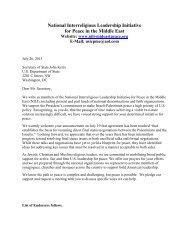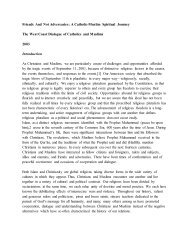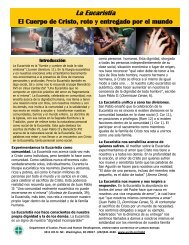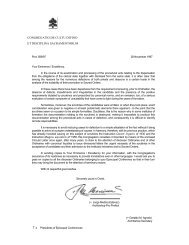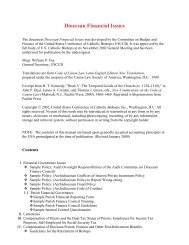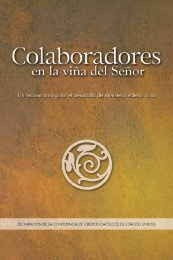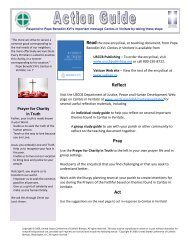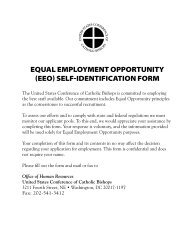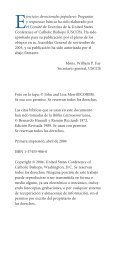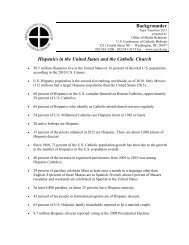Doctrinal Elements of a Curriculum Framework for the Development ...
Doctrinal Elements of a Curriculum Framework for the Development ...
Doctrinal Elements of a Curriculum Framework for the Development ...
- No tags were found...
You also want an ePaper? Increase the reach of your titles
YUMPU automatically turns print PDFs into web optimized ePapers that Google loves.
a. The Decalogue is a strong part <strong>of</strong> Catholicmoral teaching and tradition.b. Jesus Christ drew on <strong>the</strong> Decalogue and <strong>the</strong>teaching <strong>of</strong> <strong>the</strong> prophets in his teaching onself-giving love and moral living.C. Fundamental differences with <strong>the</strong> Catholic Church.1. The Jewish people do not acknowledge Jesus as aDivine Person, <strong>the</strong> Son <strong>of</strong> God, or <strong>the</strong> promisedMessiah, nor do <strong>the</strong>y accept <strong>the</strong> revealed truth<strong>of</strong> <strong>the</strong> Triune God, which is what is unique toChristian Revelation.2. The Jewish people continue to rely on <strong>the</strong> ritualprescriptions <strong>of</strong> <strong>the</strong> first Covenant reinterpreted <strong>for</strong>post-Temple Judaism.D. Anti-Judaism or anti-Semitism was evident amongCatholics <strong>for</strong> many centuries.1. The Catholic Church condemns all unjustdiscrimination, including anti-Semitism.2. In <strong>the</strong> twentieth century, <strong>the</strong> Catholic Churchdropped from its liturgy any inference that <strong>the</strong>Jewish people as a whole were responsible <strong>for</strong> <strong>the</strong>Death <strong>of</strong> Christ because <strong>the</strong> truth is that <strong>the</strong> sins <strong>of</strong>all humanity were <strong>the</strong> cause <strong>of</strong> his Death.E. Dialogue with <strong>the</strong> Jewish people.1. This dialogue has a unique character in that weshare roots <strong>of</strong> faith.2. This dialogue also has an interfaith characterbecause <strong>of</strong> <strong>the</strong> differences in faith and insacramental understanding and practice.3. Aims <strong>of</strong> this dialogue includea. Grow in mutual respect <strong>for</strong> one ano<strong>the</strong>r as sonsand daughters <strong>of</strong> God.b. Give common witness on matters <strong>of</strong> peaceand justice.c. Deepen mutual understanding <strong>of</strong> <strong>the</strong> one Godand his plan <strong>for</strong> <strong>the</strong> world.IV. The Church and O<strong>the</strong>r Non-ChristiansA. The Muslim people.1. Mono<strong>the</strong>istic (but non-Trinitarian) faith incommon with Jews and Christians.2. The Catholic Church and Muslims acknowledgeGod as <strong>the</strong> Creator and claim ties to <strong>the</strong> faith<strong>of</strong> Abraham.3. The Muslim people do not acknowledge God as <strong>the</strong>Fa<strong>the</strong>r <strong>of</strong> Jesus, or Jesus Christ as <strong>the</strong> Divine Son <strong>of</strong>God, nor do <strong>the</strong>y accept <strong>the</strong> Triune God, but <strong>the</strong>ydo revere Jesus as a prophet and Mary as <strong>the</strong> VirginMo<strong>the</strong>r <strong>of</strong> Jesus.4. There are many common elements <strong>of</strong> moral life andpractice between Catholics and Muslims.5. Islam has no sacramental economy; Islamiclaw requires testimony <strong>of</strong> faith, prayer, fasting,almsgiving, and pilgrimage as expressions <strong>of</strong> faith.6. Unlike <strong>the</strong> Catholic Church, Islam has no centralfigure <strong>of</strong> authority on matters <strong>of</strong> faith and morals;<strong>the</strong>re are also different ways to interpret <strong>the</strong>Qur’an.7. The Crusades and <strong>the</strong>ir lasting impact.8. The Catholic Church seeks to engage <strong>the</strong> Muslimcommunity in dialogue to advance humansolidarity.B. There are non-Christian religions common in <strong>the</strong>United States, including major world religions suchas Hinduism and Buddhism, and o<strong>the</strong>rs such as Sikhs,Mormons, and Bahai.1. Common elements with Christianity.a. As human beings we share a common originand end.b. Many <strong>of</strong> <strong>the</strong>se religions teach to some degreecompassionate action, moral restraint, spiritualdiscipline, and respect <strong>for</strong> human dignity.c. These religions contain elements <strong>of</strong> truth andvirtue, which can help orient <strong>the</strong>ir memberstoward reception <strong>of</strong> <strong>the</strong> Gospel.2. Those who do not know Christ but who still striveto know and live in truth and holiness can besaved.3. The fulfillment <strong>of</strong> <strong>the</strong> values and virtues <strong>of</strong>o<strong>the</strong>r religions is found in what <strong>the</strong> CatholicChurch proclaims:a. God is one, and that God is Triune.b. Jesus Christ as <strong>the</strong> Son <strong>of</strong> God.c. Salvation is a gift <strong>of</strong> grace available throughfaith in Jesus Christ.d. Sanctification is <strong>for</strong> human beings toparticipate in <strong>the</strong> love <strong>of</strong> God now andeternally.V. Proclamation and DialogueA. The Catholic Church possesses <strong>the</strong> fullness <strong>of</strong> <strong>the</strong>means <strong>of</strong> salvation willed by God as <strong>the</strong> ordinary way <strong>of</strong>saving all people.1. “All salvation comes from Christ <strong>the</strong> Head through<strong>the</strong> Church which is his Body” (CCC, no. 846).52<strong>Doctrinal</strong> <strong>Elements</strong> <strong>of</strong> a <strong>Curriculum</strong> <strong>Framework</strong> <strong>for</strong> <strong>the</strong><strong>Development</strong> <strong>of</strong> Catechetical Materials <strong>for</strong> Young People <strong>of</strong> High School Age



